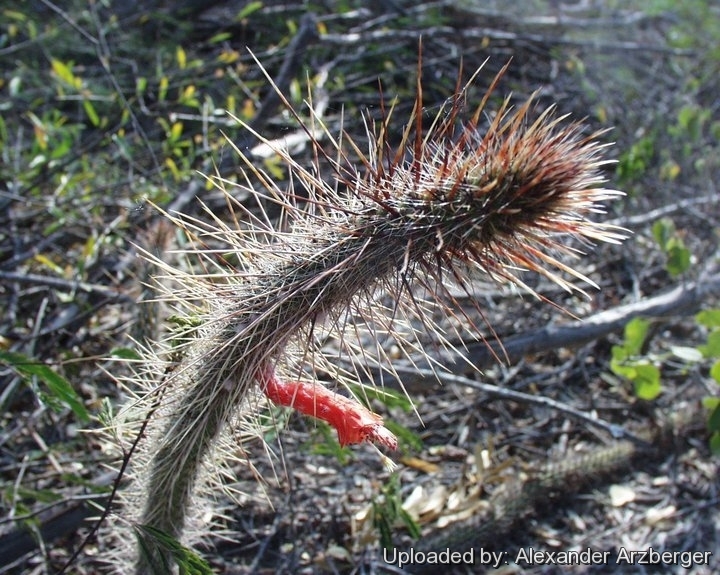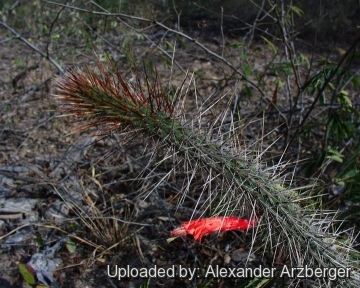Accepted Scientific Name: Cleistocactus baumannii subs. chacoanus (F.Ritter) P.J.Braun & Esteves
Succulenta (Netherlands) 74: 84. 1995

Cleistocactus chacoanus (Cleistocactus baumannii subs. chacoanus) Photo by: Alexander Arzberger
Origin and Habitat: Gran Chaco region of Bolivia (Santa Cruz, Tarija), estending in western Paraguay (Alto Paraguay, Boquerón), and northern Argentina (Salta)
Type locality: Villa Montes, Tarija, Bolivia , Prov. Gran Chaco.
Habitat and ecology. Cleistocactus baumanniiSN|4742]]SN|4742]] subsp. chacoanus is a common understory scrub also found in openings. The climate is dry tropical to semiarid.
Synonyms:
See all synonyms of Cleistocactus baumannii
Description: Cleistocactus baumanniiSN|4742]]SN|4742]] subsp. chacoanus is one of the sprawling species with thin stems, this subspecies of the widespread Cleistocactus baumanniiSN|4742]]SN|4742]] has the striking, tubular, S-shaped flowers characteristic of the species. It has thinner, rather upright stems and less ribs. As with many cleistocacti, the flowers are produced in profusion over several months on both new and old growth. It is one of the best of the sprawling cleistocactus forms. The dense thicket of dull green stems covered by long needle-like spines makes a dramatic landscape element. Sprawling cleistocacti typically produce more flowers than their columnar kin, even as young cuttings, and Cleistocactus baumanniiSN|4742]]SN|4742]] subsp. chacoanus is no exception. It is similar to Cleistocactus baumanniiSN|4742]]SN|4742]] subs. santacruzensis and sometime considered a synonym of the latter.
Derivation of specific name: 'chacoanus -a -um' for the occurrence in the Chaco (annually flooded flatlands) of Argentina, extending into Paraguay and Bolivia.
Stems: Cylindrical, branching basally, rather upright, then arching or creeping, but the tip of the shoot turned upwards (decumbent), green, 0,5-1,5 m tall, 1,5-3 cm thick.
Ribs: 8-12 ribs, slightly crenate (notched), 3-4 mm high.
Areoles: Almost round, 2-3 mm in diameter, blackish, 5-8 mm apart.
Spines: Acicular or setiform, quite variable, straight, white, yellowish or blackish, light tipped with dark base.
Radial spines: (6-)10-12(-15), the lowermost thin, 4-12 mm long, the uppermost, if any, more colourful and slightly stronger.
Central spines: 2-4 similar to radials but stronger (two of which noticeably longer), up to 3 cm long.
Flowers: Bilaterally symmetrical 55-65 mm long. Nectar-chamber 6-8 mm long, 3-4 mm wide. Tube almost cylindrical 5-7 mm in diameter, ca. 3 cm long, slightly or sharply bent upwards just above the ovary, dependending on position of the stem, reddish brown. Ovary and tube with bright scales and small white hairs in the axils. Corolla 7-12 mm wide very oblique, bent downward; petals 7-9 mm long, 4-7 mm wide, dark red. Filaments white below, and pink to purple above, rows, anthers dark lilac, protruding 5-10 mm. Style whitish, stigma lobes 6-8, green, yellow or reddish with him
Fruits: Globular or slightly elongated, crimson,1-2 cm in diameter, pulp juicy, white.
Seeds: About 1.2 mm long, 0.9 mm wide, 0.6 mm thick, ovoid to helmet shaped, keeled on the back, black, shiny, finely dotted; hilum more or less oblique.
Subspecies, varieties, forms and cultivars of plants belonging to the Cleistocactus baumannii group
 Cleistocactus baumannii (Lem.) Lem.: (subsp. baumannii) has 15-20 radial spines and red flowers. Distribution:Northeastern Argentina, Paraguay, and Uruguay.
Cleistocactus baumannii (Lem.) Lem.: (subsp. baumannii) has 15-20 radial spines and red flowers. Distribution:Northeastern Argentina, Paraguay, and Uruguay.- Cleistocactus baumannii subs. anguinus (Gürke) P.J.Braun & Esteves: decumbent with 10-11 radial spines and yellow-orange or orange-red flowers. Distribution: Paraguay.
 Cleistocactus baumannii subs. chacoanus (F.Ritter) P.J.Braun & Esteves: has more erect shoots, with less ribs, 12-15 radial spines and shorter bilaterally symmetrical flowers, usually red. Distribution: Gran Chaco region of Bolivia.
Cleistocactus baumannii subs. chacoanus (F.Ritter) P.J.Braun & Esteves: has more erect shoots, with less ribs, 12-15 radial spines and shorter bilaterally symmetrical flowers, usually red. Distribution: Gran Chaco region of Bolivia.- Cleistocactus baumannii subs. croceiflorus (F.Ritter) P.J.Braun & Esteves: has 8-12 radial spines and yellow flowers. Distribution: Puerto Casado, Alto Paraguay department, Paraguay.
 Cleistocactus baumannii subs. horstii (P.J.Braun) N.P.Taylor: has 11-15 radial spines and bilaterally symmetrical flowers, orange-red. Distribution: Mato Grosso do Sul, Brazil.
Cleistocactus baumannii subs. horstii (P.J.Braun) N.P.Taylor: has 11-15 radial spines and bilaterally symmetrical flowers, orange-red. Distribution: Mato Grosso do Sul, Brazil. Cleistocactus baumannii var. paraguariensis (F.Ritter) P.J.Braun & Esteves: 12-15, yellow to reddish yellow with darker tips, and 4-5, reddish brown centrals. Distribution: Paraguari department, Paraguay.
Cleistocactus baumannii var. paraguariensis (F.Ritter) P.J.Braun & Esteves: 12-15, yellow to reddish yellow with darker tips, and 4-5, reddish brown centrals. Distribution: Paraguari department, Paraguay.- Cleistocactus baumannii subs. santacruzensis (Backeb.) Mottram: has fewer but more elevated ribs, only about 10 radial spines and red flowers (perhaps the same as subsp. anguinus), Anthers barely protruding. Distribution: Santa Cruz, Bolivia.
- Cleistocactus bruneispinus Backeb.: has brown spines. Distribution Cochabamba, Bolivia.
- Cleistocactus margaritanus hort.: has dense yellowish bristly soft spines and orange-red S-shaped blooms, and seems related to subs. chacoanus. Distribution: Margarita, Tarija, Bolivia
- Cleistocactus margaritanus f. cristatus hort.: crested form.
Bibliography: Major references and further lectures
1) Graham Charles “Cacti and Succulents: An illustrated guide to the plants and their cultivation” Crowood, 30 April 2014
2) “Dry Climate Gardening with Succulents” Pantheon Books, 1995
3) Christopher Cumo “Encyclopedia of Cultivated Plants: From Acacia to Zinnia [3 Volumes]: From Acacia to Zinnia” ABC-CLIO, 25 April 2013
4) Urs Eggli, Leonard E. Newton “Etymological Dictionary of Succulent Plant Names” Springer Science & Business Media, 29 June 2013
5) Friedrich Ritter “Kakteen in Südamerika - Ergebnisse meiner 20jährigen Feldforschungen: [Bolivien, Argentinen]”, Volume 2, 671 (-672), fig. Selbstverl., 1980
6) David Gledhill “The Names of Plants” 4th ed. Cambridge University Press 2008
7) Edward Anderson “The Cactus family” Timber Press, Incorporated, 2001
8) James Cullen, Sabina G. Knees, H. Suzanne Cubey "The European Garden Flora Flowering Plants: A Manual for the Identification of Plants Cultivated in Europe, Both Out-of-Doors and Under Glass" Cambridge University Press, 11/Aug/2011
9) David R Hunt; Nigel P Taylor; Graham Charles; International Cactaceae Systematics Group. "The New Cactus Lexicon" dh books, 2006
 Cleistocactus chacoanus (Cleistocactus baumannii subs. chacoanus) Photo by: Alexander Arzberger
Cleistocactus chacoanus (Cleistocactus baumannii subs. chacoanus) Photo by: Alexander ArzbergerSend a photo of this plant.The gallery now contains thousands of pictures, however it is possible to do even more. We are, of course, seeking photos of species not yet shown in the gallery but not only that, we are also looking for better pictures than those already present.
Read More... Cultivation and Propagation: Cleistocactus baumannii subs. chacoanus is a a much decorative hardy cactus. It is very easy to grow but tends to look untidy in the collection if not staked. It is recommended as one of the best of the sprawling cleistocactus forms, with the added benefit of being reliably hardy.
Growth rate: It grows rapidly enough to need pruning.
Soil: Grow it in a rich and particularly draining substratum, as it is very sensitive to rottenness when in presence of humidity and low temperatures and let the soil dry out between waterings.
Water: It needs plenty of water in the summer (during the vegetative period) when it will flower for months, but allowing the substratum to completely dry up before irrigating again; in winter, it’s to be kept dry. Preferable not to water on overcast days, humid days or cold winter days.
Hardiness: This is one of hardiest of the woolly columnar cacti from Bolivia that grow at an altitude of up to 1000 meters. It is a frost resistant cactus, hardy to -7°(or even less if very dry). However in cultivation it is better not to expose it to temperatures lower than 0° C, even if in an aerated and protected location, in order to avoid the formation of anti-aesthetic spots on the epidermis. In presence of high atmospheric humidity avoid any frost as it is particularly sensitive to root rot.
Exposure: It need full sun exposures with ample airflow to produce dense hairs, but, as a former mountain dweller, does not care for extremely high temperatures in summer.
Maintenance: Repot in the spring, when their roots become cramped. Generally, they should be repotted every other year in order to provide fresh soil. After repotting, do not water for a week or more. As with many cleistocacti, the flowers are produced in profusion: the dead ones just fall off so need to be regularly tidied up. It will probably benefit from the occasional pruning to keep it in check and provide cuttings for propagation. Otdoors clumps need renewal after five to ten years, done by removing old growth.
Use: Excellent as landscape or patio plant. It is suitable for small “desert” gardens, in association with other xerophytes. Where the open air cultivation is not possible due to the climate, it is to be cultivated in pot in order to shelter it in winter.
Propagation: By seeds and by cuttings, provided left drying up well, in summer.











